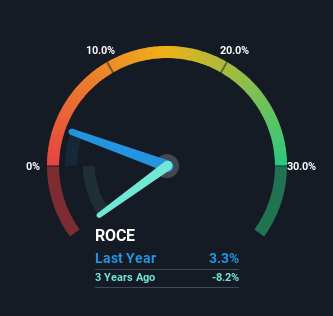- China
- /
- Semiconductors
- /
- SHSE:688153
Vanchip (Tianjin) Technology (SHSE:688153) Is Looking To Continue Growing Its Returns On Capital

What are the early trends we should look for to identify a stock that could multiply in value over the long term? Amongst other things, we'll want to see two things; firstly, a growing return on capital employed (ROCE) and secondly, an expansion in the company's amount of capital employed. Ultimately, this demonstrates that it's a business that is reinvesting profits at increasing rates of return. With that in mind, we've noticed some promising trends at Vanchip (Tianjin) Technology (SHSE:688153) so let's look a bit deeper.
Return On Capital Employed (ROCE): What Is It?
If you haven't worked with ROCE before, it measures the 'return' (pre-tax profit) a company generates from capital employed in its business. The formula for this calculation on Vanchip (Tianjin) Technology is:
Return on Capital Employed = Earnings Before Interest and Tax (EBIT) ÷ (Total Assets - Current Liabilities)
0.033 = CN¥129m ÷ (CN¥4.8b - CN¥826m) (Based on the trailing twelve months to December 2023).
Therefore, Vanchip (Tianjin) Technology has an ROCE of 3.3%. In absolute terms, that's a low return and it also under-performs the Semiconductor industry average of 4.9%.
See our latest analysis for Vanchip (Tianjin) Technology

Above you can see how the current ROCE for Vanchip (Tianjin) Technology compares to its prior returns on capital, but there's only so much you can tell from the past. If you'd like, you can check out the forecasts from the analysts covering Vanchip (Tianjin) Technology for free.
What Does the ROCE Trend For Vanchip (Tianjin) Technology Tell Us?
We're delighted to see that Vanchip (Tianjin) Technology is reaping rewards from its investments and is now generating some pre-tax profits. About five years ago the company was generating losses but things have turned around because it's now earning 3.3% on its capital. Not only that, but the company is utilizing 2,326% more capital than before, but that's to be expected from a company trying to break into profitability. We like this trend, because it tells us the company has profitable reinvestment opportunities available to it, and if it continues going forward that can lead to a multi-bagger performance.
In another part of our analysis, we noticed that the company's ratio of current liabilities to total assets decreased to 17%, which broadly means the business is relying less on its suppliers or short-term creditors to fund its operations. So shareholders would be pleased that the growth in returns has mostly come from underlying business performance.
Our Take On Vanchip (Tianjin) Technology's ROCE
In summary, it's great to see that Vanchip (Tianjin) Technology has managed to break into profitability and is continuing to reinvest in its business. And since the stock has fallen 20% over the last year, there might be an opportunity here. That being the case, research into the company's current valuation metrics and future prospects seems fitting.
One more thing to note, we've identified 1 warning sign with Vanchip (Tianjin) Technology and understanding this should be part of your investment process.
If you want to search for solid companies with great earnings, check out this free list of companies with good balance sheets and impressive returns on equity.
If you're looking to trade Vanchip (Tianjin) Technology, open an account with the lowest-cost platform trusted by professionals, Interactive Brokers.
With clients in over 200 countries and territories, and access to 160 markets, IBKR lets you trade stocks, options, futures, forex, bonds and funds from a single integrated account.
Enjoy no hidden fees, no account minimums, and FX conversion rates as low as 0.03%, far better than what most brokers offer.
Sponsored ContentNew: Manage All Your Stock Portfolios in One Place
We've created the ultimate portfolio companion for stock investors, and it's free.
• Connect an unlimited number of Portfolios and see your total in one currency
• Be alerted to new Warning Signs or Risks via email or mobile
• Track the Fair Value of your stocks
Have feedback on this article? Concerned about the content? Get in touch with us directly. Alternatively, email editorial-team (at) simplywallst.com.
This article by Simply Wall St is general in nature. We provide commentary based on historical data and analyst forecasts only using an unbiased methodology and our articles are not intended to be financial advice. It does not constitute a recommendation to buy or sell any stock, and does not take account of your objectives, or your financial situation. We aim to bring you long-term focused analysis driven by fundamental data. Note that our analysis may not factor in the latest price-sensitive company announcements or qualitative material. Simply Wall St has no position in any stocks mentioned.
About SHSE:688153
Vanchip (Tianjin) Technology
Designs, manufactures, and sells radio frequency front end and high end analog chips in China.
High growth potential with adequate balance sheet.
Market Insights
Community Narratives



